外研版英语(一年级起点)四年级下册Module 7 表格式教学设计
文档属性
| 名称 | 外研版英语(一年级起点)四年级下册Module 7 表格式教学设计 | 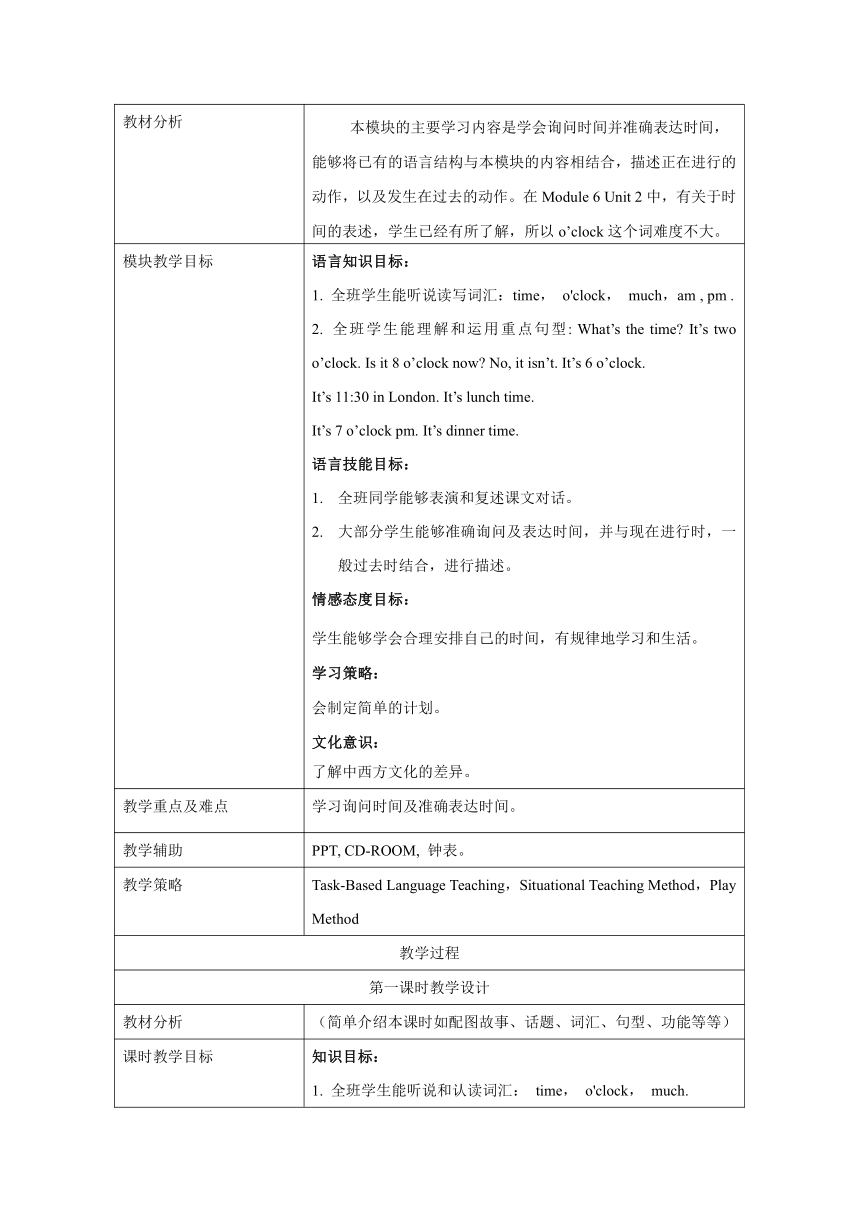 | |
| 格式 | docx | ||
| 文件大小 | 3.2MB | ||
| 资源类型 | 教案 | ||
| 版本资源 | 外研版(一年级起点) | ||
| 科目 | 英语 | ||
| 更新时间 | 2023-01-03 18:17:23 | ||
图片预览

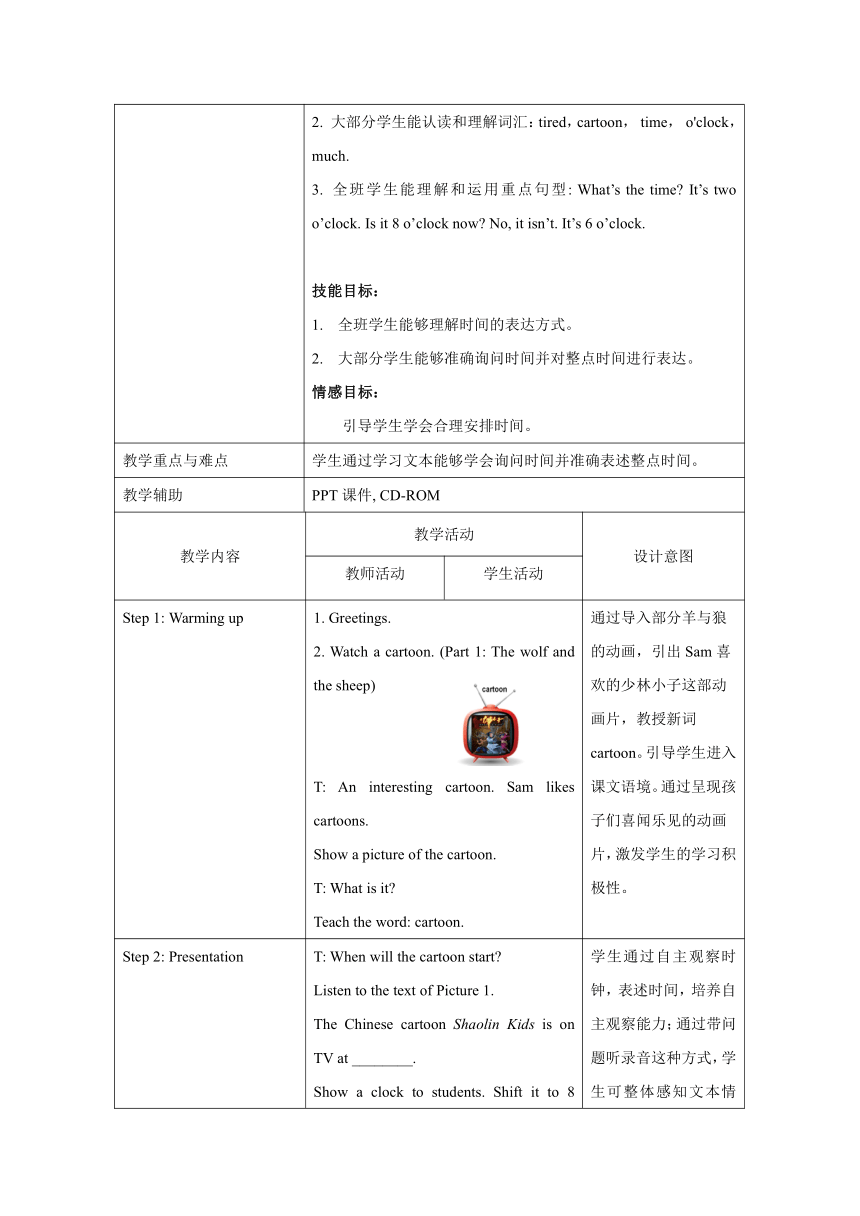
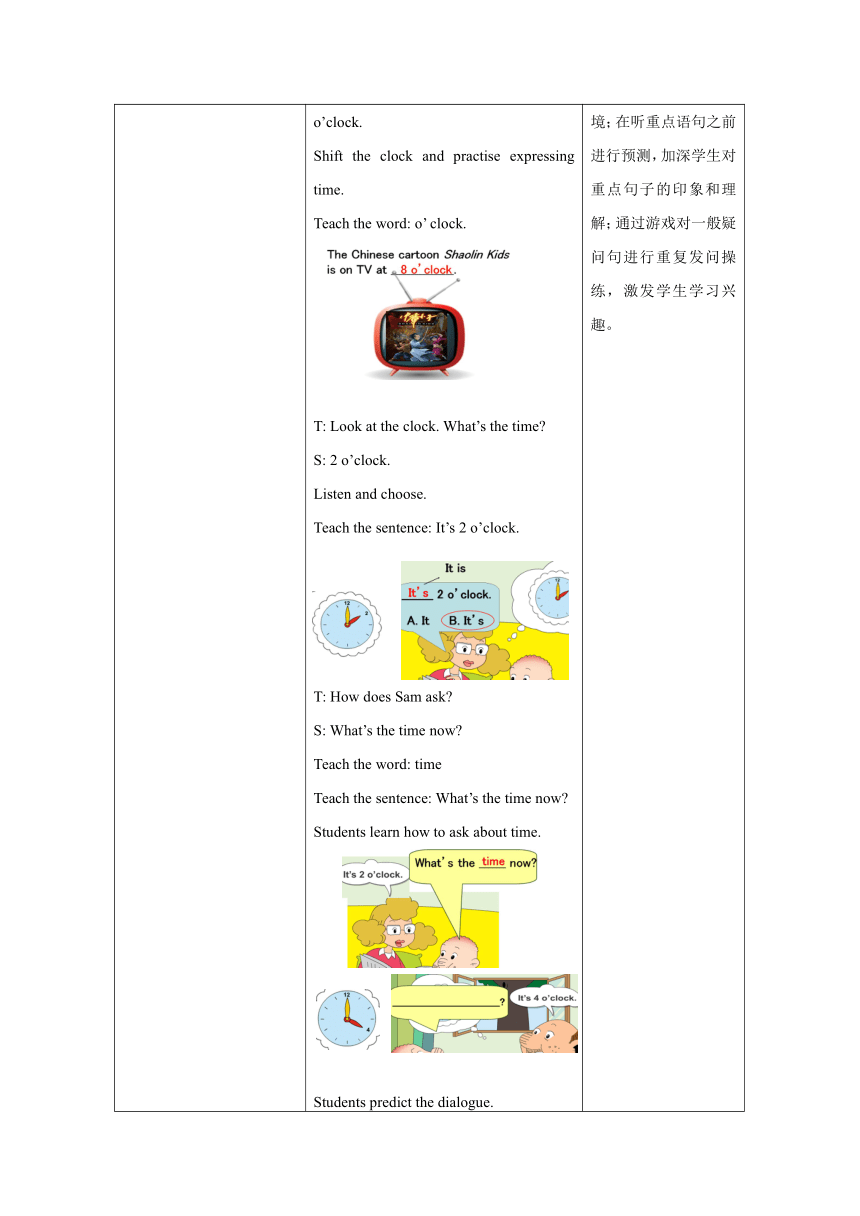
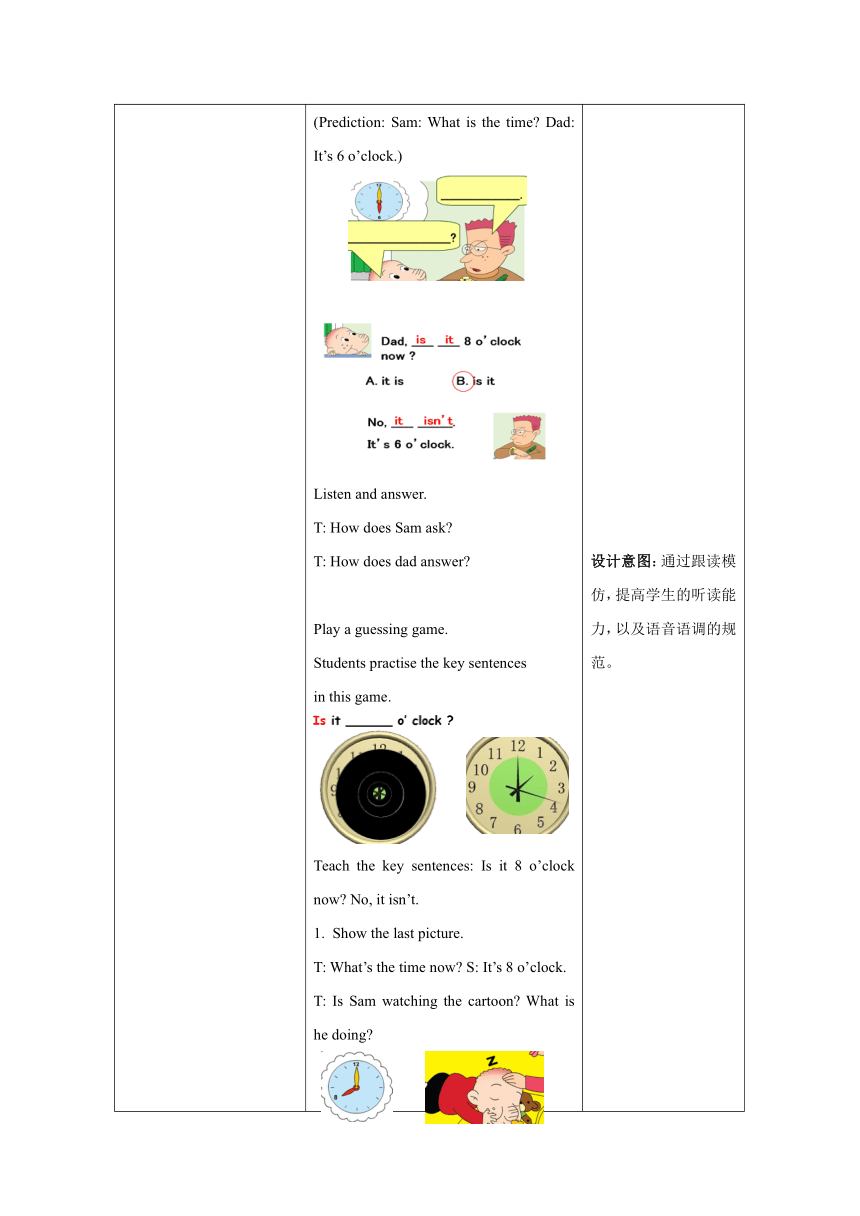
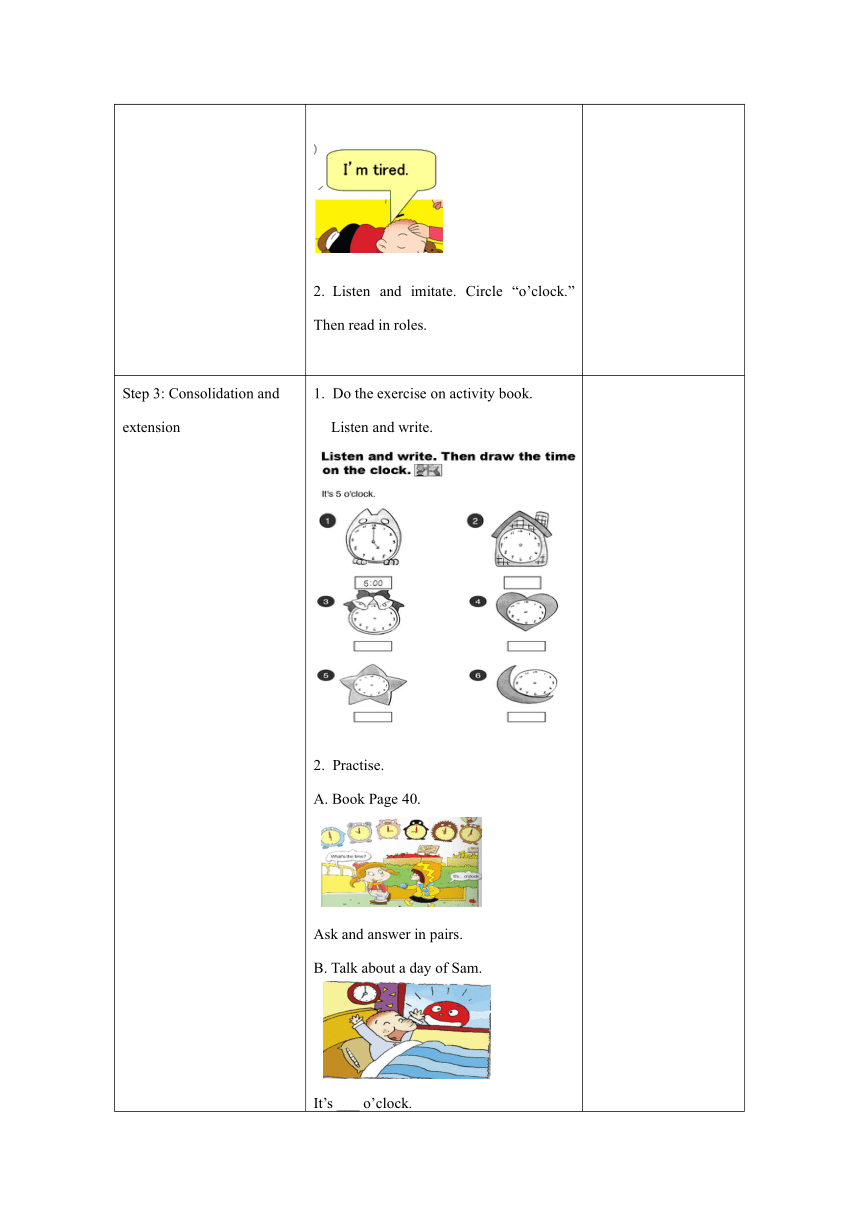
文档简介
教材分析 本模块的主要学习内容是学会询问时间并准确表达时间,能够将已有的语言结构与本模块的内容相结合,描述正在进行的动作,以及发生在过去的动作。在Module 6 Unit 2中,有关于时间的表述,学生已经有所了解,所以o’clock这个词难度不大。
模块教学目标 语言知识目标: 1. 全班学生能听说读写词汇:time, o'clock, much,am , pm . 2. 全班学生能理解和运用重点句型: What’s the time It’s two o’clock. Is it 8 o’clock now No, it isn’t. It’s 6 o’clock. It’s 11:30 in London. It’s lunch time. It’s 7 o’clock pm. It’s dinner time. 语言技能目标: 全班同学能够表演和复述课文对话。 大部分学生能够准确询问及表达时间,并与现在进行时,一般过去时结合,进行描述。 情感态度目标: 学生能够学会合理安排自己的时间,有规律地学习和生活。 学习策略: 会制定简单的计划。 文化意识: 了解中西方文化的差异。
教学重点及难点 学习询问时间及准确表达时间。
教学辅助 PPT, CD-ROOM, 钟表。
教学策略 Task-Based Language Teaching,Situational Teaching Method,Play Method
教学过程
第一课时教学设计
教材分析 (简单介绍本课时如配图故事、话题、词汇、句型、功能等等)
课时教学目标 知识目标: 1. 全班学生能听说和认读词汇: time, o'clock, much. 2. 大部分学生能认读和理解词汇:tired,cartoon, time, o'clock,much. 3. 全班学生能理解和运用重点句型: What’s the time It’s two o’clock. Is it 8 o’clock now No, it isn’t. It’s 6 o’clock. 技能目标: 全班学生能够理解时间的表达方式。 大部分学生能够准确询问时间并对整点时间进行表达。 情感目标: 引导学生学会合理安排时间。
教学重点与难点 学生通过学习文本能够学会询问时间并准确表述整点时间。
教学辅助 PPT课件, CD-ROM
教学内容 教学活动 设计意图
教师活动 学生活动
Step 1: Warming up 1. Greetings. 2. Watch a cartoon. (Part 1: The wolf and the sheep) T: An interesting cartoon. Sam likes cartoons. Show a picture of the cartoon. T: What is it Teach the word: cartoon. 通过导入部分羊与狼的动画,引出Sam喜欢的少林小子这部动画片,教授新词cartoon。引导学生进入课文语境。通过呈现孩子们喜闻乐见的动画片,激发学生的学习积极性。
Step 2: Presentation T: When will the cartoon start Listen to the text of Picture 1. The Chinese cartoon Shaolin Kids is on TV at ________. Show a clock to students. Shift it to 8 o’clock. Shift the clock and practise expressing time. Teach the word: o’ clock. T: Look at the clock. What’s the time S: 2 o’clock. Listen and choose. Teach the sentence: It’s 2 o’clock. T: How does Sam ask S: What’s the time now Teach the word: time Teach the sentence: What’s the time now Students learn how to ask about time. Students predict the dialogue. (Prediction: Sam: What is the time Dad: It’s 6 o’clock.) Listen and answer. T: How does Sam ask T: How does dad answer Play a guessing game. Students practise the key sentences in this game. Teach the key sentences: Is it 8 o’clock now No, it isn’t. Show the last picture. T: What’s the time now S: It’s 8 o’clock. T: Is Sam watching the cartoon What is he doing Listen and imitate. Circle “o’clock.” Then read in roles. 学生通过自主观察时钟,表述时间,培养自主观察能力;通过带问题听录音这种方式,学生可整体感知文本情境;在听重点语句之前进行预测,加深学生对重点句子的印象和理解;通过游戏对一般疑问句进行重复发问操练,激发学生学习兴趣。 设计意图:通过跟读模仿,提高学生的听读能力,以及语音语调的规范。
Step 3: Consolidation and extension Do the exercise on activity book. Listen and write. Practise. A. Book Page 40. Ask and answer in pairs. B. Talk about a day of Sam. It’s ___ o’clock. Sam is _____ _____. It’s ____ o’clock. Sam is ____. It’s ____ o’clock in the morning. Sam is _____ _____. It’s ____ o’clock. Sam is _____ . 3. Group work. A. Use the clock needles. Ask and answer in groups.
Step 4: Summary Students sum up the key words and this lesson.
Classroom Assessment 四个钟表,分为四组,每加一分拨动一个小时,最后看哪个组数字最大。
家庭作业: 1. Listen and imitate the dialogue. 2. Ask and answer in pairs.
第二课时教学设计
教材分析 本课时在Unit 1对整点进行询问和表达的基础上,进一步学习对半点时间的表达。帮助学生明确时区概念,使学生理解不同地区的国家时间是不同的这一现象。本节课授课对象为四年级学生。学生在第一课时学习了如何询问时间以及表达整点时间。本节课将进一步学习对半点时间的表达。
课时教学目标 知识目标: 1. 全班学生能听说和认读词汇:am, pm, New York. 2. 大部分学生能认读和理解词汇:breakfast, lunch, dinner. 3. 全班学生能理解和运用重点句型:It’s 11:30 in London. It’s lunch time. 技能目标: 1.全班学生能够理解时差现象,并对时间进行询问及表达。 2.大部分学生能够描述同一时刻不同国家的不同时间以及不同时间的三餐。 情感目标: 1.学生能够具有规律生活的意识,并且合理安排时间。 2.在学习和日常交往中,能初步注意到中外文化的异同。
教学重点与难点 1. 全班学生能够准确询问时间及表达时间。 2. 大部分学生能够描述同一时刻不同国家的不同时间以及三餐。
教学辅助 PPT课件、CD-ROM。
教学策略 上课开始,让学生观看动画短片,教授单词breakfast, lunch, dinner. 然后课中通过微视频,使学生明确时差现象。
教学内容 教学活动 设计意图
教师活动 学生活动
Step 1: Warming up Look at this clock. T: Can you ask a question S: What’s the time It’s 9 o’clock. T: What do you usually do at 9 o’clock S: I _______ at 9 o’clock. T: Look, it’s 9 o’clock in the picture. Let’s watch a cartoon. Answer the question. Teach the words: breakfast, lunch, dinner. 通过观看短片引起学生兴趣,并教授breakfast, lunch, dinner这三个单词。
Step 2: Presentation Some pictures. Students know the words: breakfast, lunch, dinner. 2. Three clocks. Listen and match. Students learn am / pm in the text. Teach how to say 11:30, 7:30, 6:30. (告诉学生半点的表达方法就是分别读出冒号前后的两个数字即可。) 3. Watch a video about time differences(时差) T: Different countries, different times. Listen and match. 通过观看微视频,使学生了解时差现象产生的原因,从而对文本有进一步的理解。 学生通过连线,了解这三个城市的不同时间。
Step 3: Consolidation and extension Do the exercise on activity book. Page 28 1. Listen and number. B. Page 28 2. Read and complete. Book Page 42 3. Practise in pairs. 学生通过活动手册的练习,进一步巩固对描述时间的学习。通过填空,进一步理解时差。
Step 4: Summary Have students sum up the key points of this lesson. 提高学生自主总结能力,并能及时补漏知识点,建构完善自己的知识框架。
Classroom Assessment 四个钟表,分为四组,每加一分拨动半个小时,最后看哪个组数字最大。
家庭作业: 1. Listen and imitate the text. 2. Do a survey. Ask your friends “When did you ______ yesterday ”
第三课时教学设计
教材分析 本课时在第一、二课时的基础上,帮助学生进一步巩固时间的询问及表达,引导学生运用模块目标语言,提高书面和口头表达能力。本节课授课对象为四年级学生。基本掌握了运用特殊疑问句及一般疑问句询问时间,以及表述整点及半点时间。本节课将进一步引导学生运用模块目标语言及之前学过的过去时态,学习描述时间及事件。
课时教学目标 知识目标: 1. 全班学生能听说读写词汇:time, o'clock, much, am, pm. 2. 全班学生能理解和运用重点句型: What’s the time It’s two o’clock. Is it 8 o’clock now No, it isn’t. It’s 6 o’clock. It’s 11:30 in London. It’s lunch time. 技能目标: 1. 全班同学能够表演和复述课文对话。 2. 大部分学生能够准确询问及表达时间。大部分学生能够描述他人在特定的时间点所做的事情。 3. 能够制定简单的一日计划。 情感目标: 学生能够学会合理安排自己的时间,有规律的学习和生活;了解中西方文化的差异。
教学重点与难点 1. 全班学生能够准确询问及表达时间。 2. 学生能够与同伴一起,根据调查时间表做一个对话。
教学辅助 PPT课件、CD-ROM。
教学策略 课前学生通过做调查作业时间表,对于自己的时间安排有所了解。为本节课的语言输出做好铺垫。通过小组合作活动,从口语和书面表达两方面提高学生的听说和书写能力。并通过这次小组活动,使学生进一步理解合理安排时间的重要性。
教学内容 教学活动 设计意图
教师活动 学生活动
Step 1: Review Act out the dialogue of Unit 1. Fill in the blanks. 1. 通过表演对话,复习文本,同时创设轻松的学习氛围。 2. 学生通过讨论和填空复习文本内容,为任务活动做好语言铺垫。
Step 2: Read a passage 文本: (文本情景是玲玲去伦敦旅游,给在中国的大明打电话。) Daming: Hi, Lingling. Lingling: Hi, Daming. Daming: What are you doing Lingling: I’m at the Big Ben. It’s really a big clock. Daming: Really What’s the time now Lingling: Guess! Daming: Is it 10 o’clock now Lingling: No, it isn’t. Daming: Is it 7:30 Lingling: Yes, it is. Daming: Is it dinner time now Lingling: No, it isn’t. It’s 7:30 am. It’s breakfast time. What’s the time in Beijing now Daming: It’s 3:30 pm. I am doing my homework. Have a good time, Lingling. Lingling: OK. Thank you. Good bye. Daming: Bye. 1. Students read the passage by themselves and answer the questions in groups: 1) Where is Lingling Where is Daming 2) What is the time in London 3) What is the time in Beijing 4) Is it dinner time in London 5) What is Daming doing 2. Do a survey. Read the phrases together. Review past-tense. 2) Give an example. A: When did you get up yesterday B: I got up at 6:30. 3) Do the survey. 4) Show: Make a dialogue in pairs. 学生通过做调查,在真实的语境中反复运用目标语言,然后根据调查时间表,与调查对象一起在语言支架的辅助下完成一个小对话。培养学生的合作意识和自主学习能力,通过语言输出,提高学生对目标语言的综合运用能力。
Step 3: Summary Have students sum up the key points of this lesson. 提高学生自主总结能力,并能及时补漏知识点,建构完善自己的知识框架。
Classroom Assessment
家庭作业: 1. Finish the survey. And make a dialogue with your partner. 2. Make a plan for tomorrow.
模块教学目标 语言知识目标: 1. 全班学生能听说读写词汇:time, o'clock, much,am , pm . 2. 全班学生能理解和运用重点句型: What’s the time It’s two o’clock. Is it 8 o’clock now No, it isn’t. It’s 6 o’clock. It’s 11:30 in London. It’s lunch time. It’s 7 o’clock pm. It’s dinner time. 语言技能目标: 全班同学能够表演和复述课文对话。 大部分学生能够准确询问及表达时间,并与现在进行时,一般过去时结合,进行描述。 情感态度目标: 学生能够学会合理安排自己的时间,有规律地学习和生活。 学习策略: 会制定简单的计划。 文化意识: 了解中西方文化的差异。
教学重点及难点 学习询问时间及准确表达时间。
教学辅助 PPT, CD-ROOM, 钟表。
教学策略 Task-Based Language Teaching,Situational Teaching Method,Play Method
教学过程
第一课时教学设计
教材分析 (简单介绍本课时如配图故事、话题、词汇、句型、功能等等)
课时教学目标 知识目标: 1. 全班学生能听说和认读词汇: time, o'clock, much. 2. 大部分学生能认读和理解词汇:tired,cartoon, time, o'clock,much. 3. 全班学生能理解和运用重点句型: What’s the time It’s two o’clock. Is it 8 o’clock now No, it isn’t. It’s 6 o’clock. 技能目标: 全班学生能够理解时间的表达方式。 大部分学生能够准确询问时间并对整点时间进行表达。 情感目标: 引导学生学会合理安排时间。
教学重点与难点 学生通过学习文本能够学会询问时间并准确表述整点时间。
教学辅助 PPT课件, CD-ROM
教学内容 教学活动 设计意图
教师活动 学生活动
Step 1: Warming up 1. Greetings. 2. Watch a cartoon. (Part 1: The wolf and the sheep) T: An interesting cartoon. Sam likes cartoons. Show a picture of the cartoon. T: What is it Teach the word: cartoon. 通过导入部分羊与狼的动画,引出Sam喜欢的少林小子这部动画片,教授新词cartoon。引导学生进入课文语境。通过呈现孩子们喜闻乐见的动画片,激发学生的学习积极性。
Step 2: Presentation T: When will the cartoon start Listen to the text of Picture 1. The Chinese cartoon Shaolin Kids is on TV at ________. Show a clock to students. Shift it to 8 o’clock. Shift the clock and practise expressing time. Teach the word: o’ clock. T: Look at the clock. What’s the time S: 2 o’clock. Listen and choose. Teach the sentence: It’s 2 o’clock. T: How does Sam ask S: What’s the time now Teach the word: time Teach the sentence: What’s the time now Students learn how to ask about time. Students predict the dialogue. (Prediction: Sam: What is the time Dad: It’s 6 o’clock.) Listen and answer. T: How does Sam ask T: How does dad answer Play a guessing game. Students practise the key sentences in this game. Teach the key sentences: Is it 8 o’clock now No, it isn’t. Show the last picture. T: What’s the time now S: It’s 8 o’clock. T: Is Sam watching the cartoon What is he doing Listen and imitate. Circle “o’clock.” Then read in roles. 学生通过自主观察时钟,表述时间,培养自主观察能力;通过带问题听录音这种方式,学生可整体感知文本情境;在听重点语句之前进行预测,加深学生对重点句子的印象和理解;通过游戏对一般疑问句进行重复发问操练,激发学生学习兴趣。 设计意图:通过跟读模仿,提高学生的听读能力,以及语音语调的规范。
Step 3: Consolidation and extension Do the exercise on activity book. Listen and write. Practise. A. Book Page 40. Ask and answer in pairs. B. Talk about a day of Sam. It’s ___ o’clock. Sam is _____ _____. It’s ____ o’clock. Sam is ____. It’s ____ o’clock in the morning. Sam is _____ _____. It’s ____ o’clock. Sam is _____ . 3. Group work. A. Use the clock needles. Ask and answer in groups.
Step 4: Summary Students sum up the key words and this lesson.
Classroom Assessment 四个钟表,分为四组,每加一分拨动一个小时,最后看哪个组数字最大。
家庭作业: 1. Listen and imitate the dialogue. 2. Ask and answer in pairs.
第二课时教学设计
教材分析 本课时在Unit 1对整点进行询问和表达的基础上,进一步学习对半点时间的表达。帮助学生明确时区概念,使学生理解不同地区的国家时间是不同的这一现象。本节课授课对象为四年级学生。学生在第一课时学习了如何询问时间以及表达整点时间。本节课将进一步学习对半点时间的表达。
课时教学目标 知识目标: 1. 全班学生能听说和认读词汇:am, pm, New York. 2. 大部分学生能认读和理解词汇:breakfast, lunch, dinner. 3. 全班学生能理解和运用重点句型:It’s 11:30 in London. It’s lunch time. 技能目标: 1.全班学生能够理解时差现象,并对时间进行询问及表达。 2.大部分学生能够描述同一时刻不同国家的不同时间以及不同时间的三餐。 情感目标: 1.学生能够具有规律生活的意识,并且合理安排时间。 2.在学习和日常交往中,能初步注意到中外文化的异同。
教学重点与难点 1. 全班学生能够准确询问时间及表达时间。 2. 大部分学生能够描述同一时刻不同国家的不同时间以及三餐。
教学辅助 PPT课件、CD-ROM。
教学策略 上课开始,让学生观看动画短片,教授单词breakfast, lunch, dinner. 然后课中通过微视频,使学生明确时差现象。
教学内容 教学活动 设计意图
教师活动 学生活动
Step 1: Warming up Look at this clock. T: Can you ask a question S: What’s the time It’s 9 o’clock. T: What do you usually do at 9 o’clock S: I _______ at 9 o’clock. T: Look, it’s 9 o’clock in the picture. Let’s watch a cartoon. Answer the question. Teach the words: breakfast, lunch, dinner. 通过观看短片引起学生兴趣,并教授breakfast, lunch, dinner这三个单词。
Step 2: Presentation Some pictures. Students know the words: breakfast, lunch, dinner. 2. Three clocks. Listen and match. Students learn am / pm in the text. Teach how to say 11:30, 7:30, 6:30. (告诉学生半点的表达方法就是分别读出冒号前后的两个数字即可。) 3. Watch a video about time differences(时差) T: Different countries, different times. Listen and match. 通过观看微视频,使学生了解时差现象产生的原因,从而对文本有进一步的理解。 学生通过连线,了解这三个城市的不同时间。
Step 3: Consolidation and extension Do the exercise on activity book. Page 28 1. Listen and number. B. Page 28 2. Read and complete. Book Page 42 3. Practise in pairs. 学生通过活动手册的练习,进一步巩固对描述时间的学习。通过填空,进一步理解时差。
Step 4: Summary Have students sum up the key points of this lesson. 提高学生自主总结能力,并能及时补漏知识点,建构完善自己的知识框架。
Classroom Assessment 四个钟表,分为四组,每加一分拨动半个小时,最后看哪个组数字最大。
家庭作业: 1. Listen and imitate the text. 2. Do a survey. Ask your friends “When did you ______ yesterday ”
第三课时教学设计
教材分析 本课时在第一、二课时的基础上,帮助学生进一步巩固时间的询问及表达,引导学生运用模块目标语言,提高书面和口头表达能力。本节课授课对象为四年级学生。基本掌握了运用特殊疑问句及一般疑问句询问时间,以及表述整点及半点时间。本节课将进一步引导学生运用模块目标语言及之前学过的过去时态,学习描述时间及事件。
课时教学目标 知识目标: 1. 全班学生能听说读写词汇:time, o'clock, much, am, pm. 2. 全班学生能理解和运用重点句型: What’s the time It’s two o’clock. Is it 8 o’clock now No, it isn’t. It’s 6 o’clock. It’s 11:30 in London. It’s lunch time. 技能目标: 1. 全班同学能够表演和复述课文对话。 2. 大部分学生能够准确询问及表达时间。大部分学生能够描述他人在特定的时间点所做的事情。 3. 能够制定简单的一日计划。 情感目标: 学生能够学会合理安排自己的时间,有规律的学习和生活;了解中西方文化的差异。
教学重点与难点 1. 全班学生能够准确询问及表达时间。 2. 学生能够与同伴一起,根据调查时间表做一个对话。
教学辅助 PPT课件、CD-ROM。
教学策略 课前学生通过做调查作业时间表,对于自己的时间安排有所了解。为本节课的语言输出做好铺垫。通过小组合作活动,从口语和书面表达两方面提高学生的听说和书写能力。并通过这次小组活动,使学生进一步理解合理安排时间的重要性。
教学内容 教学活动 设计意图
教师活动 学生活动
Step 1: Review Act out the dialogue of Unit 1. Fill in the blanks. 1. 通过表演对话,复习文本,同时创设轻松的学习氛围。 2. 学生通过讨论和填空复习文本内容,为任务活动做好语言铺垫。
Step 2: Read a passage 文本: (文本情景是玲玲去伦敦旅游,给在中国的大明打电话。) Daming: Hi, Lingling. Lingling: Hi, Daming. Daming: What are you doing Lingling: I’m at the Big Ben. It’s really a big clock. Daming: Really What’s the time now Lingling: Guess! Daming: Is it 10 o’clock now Lingling: No, it isn’t. Daming: Is it 7:30 Lingling: Yes, it is. Daming: Is it dinner time now Lingling: No, it isn’t. It’s 7:30 am. It’s breakfast time. What’s the time in Beijing now Daming: It’s 3:30 pm. I am doing my homework. Have a good time, Lingling. Lingling: OK. Thank you. Good bye. Daming: Bye. 1. Students read the passage by themselves and answer the questions in groups: 1) Where is Lingling Where is Daming 2) What is the time in London 3) What is the time in Beijing 4) Is it dinner time in London 5) What is Daming doing 2. Do a survey. Read the phrases together. Review past-tense. 2) Give an example. A: When did you get up yesterday B: I got up at 6:30. 3) Do the survey. 4) Show: Make a dialogue in pairs. 学生通过做调查,在真实的语境中反复运用目标语言,然后根据调查时间表,与调查对象一起在语言支架的辅助下完成一个小对话。培养学生的合作意识和自主学习能力,通过语言输出,提高学生对目标语言的综合运用能力。
Step 3: Summary Have students sum up the key points of this lesson. 提高学生自主总结能力,并能及时补漏知识点,建构完善自己的知识框架。
Classroom Assessment
家庭作业: 1. Finish the survey. And make a dialogue with your partner. 2. Make a plan for tomorrow.
同课章节目录
- Module 1
- Unit 1 Don't touch the machines ,please!
- Unit 2 Don't feed the fish!
- Module 2
- Unit 1 It's cheap.
- Unit 2 It costs one hundred and eighteen yuan.
- Module 3
- Unit 1 He shouted "Wolf, wolf!”
- Unit 2 She went into a shop.
- Module 4
- Unit 1 Dad played the erhu.
- Unit 2 I was very nervous.
- Module 5
- Unit 1 We're having a party.
- Unit 2 He's drawing books and birds.
- Module 6
- Unit 1 I'll draw the pictures.
- Unit 2 Let's have fun this Saturday!
- Module 7
- Unit 1 What's the time?
- Unit 2 It's 6:30 am in New York.
- Module 8
- Unit 1 He lives in the east of the US.
- Unit 2 It's in the north of China.
- Module 9
- Unit 1 Why do you like Australia?
- Unit 2 Kangaroos live in Australia.
- Module 10
- Unit 1 I'll send you a postcard.
- Unit 2 I'm going to visit London.
- Review Module
- Unit 1
- Unit 2
